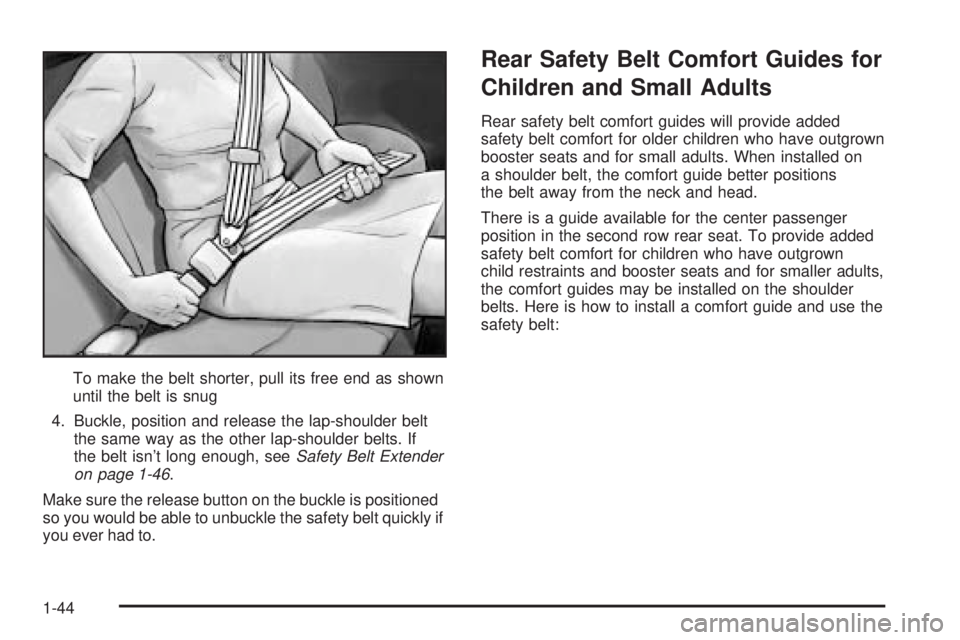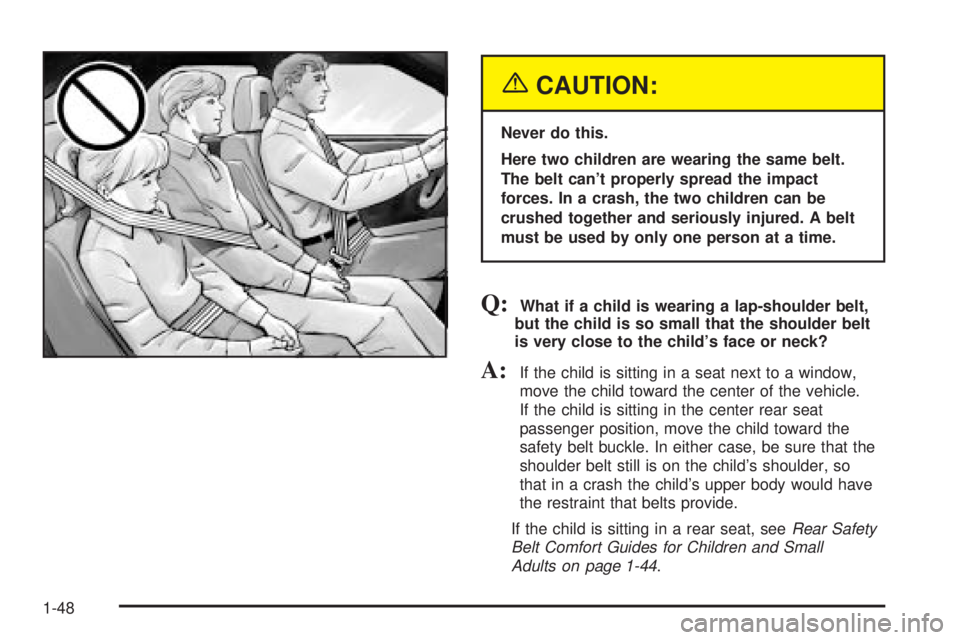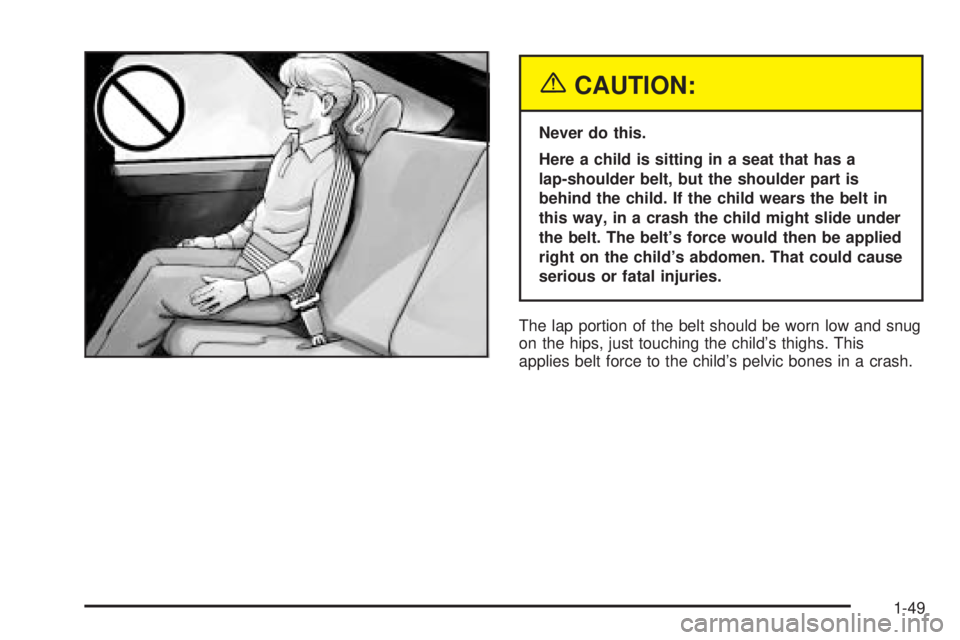2004 BUICK RANDEZVOUS child seat
[x] Cancel search: child seatPage 1 of 486

Seats and Restraint Systems........................... 1-1
Front Seats
............................................... 1-3
Rear Seats
............................................... 1-9
Safety Belts
.............................................1-22
Child Restraints
.......................................1-47
Air Bag Systems
......................................1-72
Restraint System Check
............................1-82
Features and Controls..................................... 2-1
Keys
........................................................ 2-3
Doors and Locks
....................................... 2-8
Windows
.................................................2-13
Theft-Deterrent Systems
............................2-15
Starting and Operating Your Vehicle
...........2-19
Mirrors
....................................................2-32
OnStar
®System
......................................2-33
HomeLink®Transmitter
.............................2-35
Storage Areas
.........................................2-39
Sunroof
..................................................2-48
Vehicle Personalization
.............................2-49
Instrument Panel............................................. 3-1
Instrument Panel Overview
.......................... 3-4
Climate Controls
......................................3-28
Warning Lights, Gages and Indicators
.........3-39
Message Center
.......................................3-50Driver Information Center (DIC)
..................3-60
Audio System(s)
.......................................3-73
Driving Your Vehicle....................................... 4-1
Your Driving, the Road, and Your Vehicle
..... 4-2
Towing
...................................................4-33
Service and Appearance Care.......................... 5-1
Service
..................................................... 5-3
Fuel
......................................................... 5-4
Checking Things Under the Hood
...............5-10
All-Wheel Drive
........................................5-48
Bulb Replacement
....................................5-50
Windshield Wiper Blade Replacement
.........5-55
Tires
......................................................5-57
Appearance Care
.....................................5-99
Vehicle Identi�cation
...............................5-107
Electrical System
....................................5-108
Capacities and Speci�cations
...................5-115
Maintenance Schedule..................................... 6-1
Maintenance Schedule
................................ 6-2
Customer Assistance Information.................... 7-1
Customer Assistance Information
.................. 7-2
Reporting Safety Defects
...........................7-11
Index................................................................ 1
2004 Buick Rendezvous Owner ManualM
Page 7 of 486

Front Seats......................................................1-3
Manual Passenger Seat..................................1-3
Four-Way Manual Driver Seat..........................1-3
Six-Way Power Seats.....................................1-5
Manual Lumbar..............................................1-5
Heated Seats.................................................1-6
Reclining Seatbacks........................................1-6
Head Restraints.............................................1-8
Rear Seats.......................................................1-9
Rear Seat Operation.......................................1-9
Split Bench Seats...........................................1-9
Captain Chairs.............................................1-14
Stowable Seat..............................................1-18
Safety Belts...................................................1-22
Safety Belts: They Are for Everyone................1-22
Questions and Answers About Safety Belts......1-26
How to Wear Safety Belts Properly.................1-27
Driver Position..............................................1-28
Safety Belt Use During Pregnancy..................1-36
Right Front Passenger Position.......................1-37
Rear Seat Passengers..................................1-38
Center Rear Passenger Position.....................1-42Rear Safety Belt Comfort Guides for Children
and Small Adults.......................................1-44
Safety Belt Pretensioners...............................1-46
Safety Belt Extender.....................................1-46
Child Restraints.............................................1-47
Older Children..............................................1-47
Infants and Young Children............................1-50
Child Restraint Systems.................................1-53
Where to Put the Restraint.............................1-56
Top Strap....................................................1-57
Top Strap Anchor Location.............................1-58
Lower Anchorages and Top Tethers for
Children (LATCH System)...........................1-62
Securing a Child Restraint Designed for the
LATCH System.........................................1-64
Securing a Child Restraint in a Rear Outside
Seat Position............................................1-64
Securing a Child Restraint in a Center Rear
Seat Position............................................1-67
Securing a Child Restraint in the Right Front
Seat Position............................................1-69
Section 1 Seats and Restraint Systems
1-1
Page 50 of 486

To make the belt shorter, pull its free end as shown
until the belt is snug
4. Buckle, position and release the lap-shoulder belt
the same way as the other lap-shoulder belts. If
the belt isn’t long enough, seeSafety Belt Extender
on page 1-46.
Make sure the release button on the buckle is positioned
so you would be able to unbuckle the safety belt quickly if
you ever had to.
Rear Safety Belt Comfort Guides for
Children and Small Adults
Rear safety belt comfort guides will provide added
safety belt comfort for older children who have outgrown
booster seats and for small adults. When installed on
a shoulder belt, the comfort guide better positions
the belt away from the neck and head.
There is a guide available for the center passenger
position in the second row rear seat. To provide added
safety belt comfort for children who have outgrown
child restraints and booster seats and for smaller adults,
the comfort guides may be installed on the shoulder
belts. Here is how to install a comfort guide and use the
safety belt:
1-44
Page 53 of 486

Child Restraints
Older Children
Older children who have outgrown booster seats should
wear the vehicle’s safety belts.
Q:What is the proper way to wear safety belts?
A:If possible, an older child should wear a
lap-shoulder belt and get the additional restraint a
shoulder belt can provide. The shoulder belt
should not cross the face or neck. The lap belt
should �t snugly below the hips, just touching the
top of the thighs. It should never be worn over
the abdomen, which could cause severe or even
fatal internal injuries in a crash.
Accident statistics show that children are safer if they
are restrained in the rear seat.
In a crash, children who are not buckled up can strike
other people who are buckled up, or can be thrown
out of the vehicle. Older children need to use safety
belts properly.
1-47
Page 54 of 486

{CAUTION:
Never do this.
Here two children are wearing the same belt.
The belt can’t properly spread the impact
forces. In a crash, the two children can be
crushed together and seriously injured. A belt
must be used by only one person at a time.
Q:What if a child is wearing a lap-shoulder belt,
but the child is so small that the shoulder belt
is very close to the child’s face or neck?
A:If the child is sitting in a seat next to a window,
move the child toward the center of the vehicle.
If the child is sitting in the center rear seat
passenger position, move the child toward the
safety belt buckle. In either case, be sure that the
shoulder belt still is on the child’s shoulder, so
that in a crash the child’s upper body would have
the restraint that belts provide.
If the child is sitting in a rear seat, seeRear Safety
Belt Comfort Guides for Children and Small
Adults on page 1-44.
1-48
Page 55 of 486

{CAUTION:
Never do this.
Here a child is sitting in a seat that has a
lap-shoulder belt, but the shoulder part is
behind the child. If the child wears the belt in
this way, in a crash the child might slide under
the belt. The belt’s force would then be applied
right on the child’s abdomen. That could cause
serious or fatal injuries.
The lap portion of the belt should be worn low and snug
on the hips, just touching the child’s thighs. This
applies belt force to the child’s pelvic bones in a crash.
1-49
Page 58 of 486

Q:What are the different types of add-on child
restraints?
A:Add-on child restraints, which are purchased by
the vehicle’s owner, are available in four basic
types. Selection of a particular restraint should take
into consideration not only the child’s weight,
height and age but also whether or not the restraint
will be compatible with the motor vehicle in
which it will be used.
For most basic types of child restraints, there are
many different models available. When purchasing a
child restraint, be sure it is designed to be used
in a motor vehicle. If it is, the restraint will have a
label saying that it meets federal motor vehicle
safety standards.
The restraint manufacturer’s instructions that come
with the restraint state the weight and height
limitations for a particular child restraint. In addition,
there are many kinds of restraints available for
children with special needs.
{CAUTION:
Newborn infants need complete support,
including support for the head and neck. This is
necessary because a newborn infant’s neck is
weak and its head weighs so much compared
with the rest of its body. In a crash, an infant in a
rear-facing seat settles into the restraint, so the
crash forces can be distributed across the
strongest part of an infant’s body, the back and
shoulders. Infants always should be secured in
appropriate infant restraints.
1-52
Page 60 of 486

A rear-facing infant seat (B) provides restraint with the
seating surface against the back of the infant. The
harness system holds the infant in place and, in a crash,
acts to keep the infant positioned in the restraint.A forward-facing child seat (C-E) provides restraint for
the child’s body with the harness and also sometimes
with surfaces such as T-shaped or shelf-like shields.
1-54